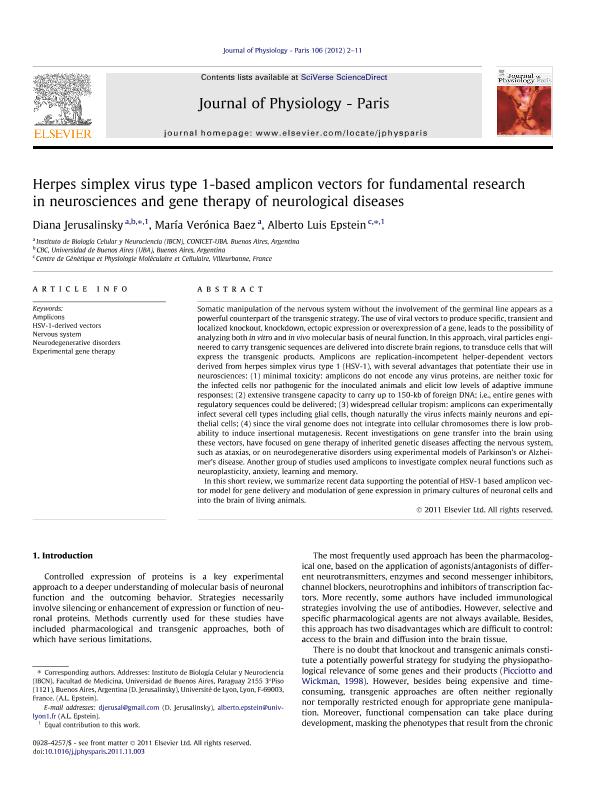Mostrar el registro sencillo del ítem
dc.contributor.author
Jerusalinsky, Diana Alicia

dc.contributor.author
Baez, Maria Veronica

dc.contributor.author
Epstein, Alberto Luis

dc.date.available
2017-05-11T15:59:12Z
dc.date.issued
2012-01
dc.identifier.citation
Jerusalinsky, Diana Alicia; Baez, Maria Veronica; Epstein, Alberto Luis; Herpes simplex virus type 1-based amplicon vectors for fundamental research in neurosciences and gene therapy of neurological diseases; Elsevier; Journal of Physiology; 106; 1-2; 1-2012; 2-11
dc.identifier.issn
0928-4257
dc.identifier.uri
http://hdl.handle.net/11336/16302
dc.description.abstract
Somatic manipulation of the nervous system without the involvement of the germinal line appears as a powerful counterpart of the transgenic strategy. The use of viral vectors to produce specific, transient and localized knockout, knockdown, ectopic expression or overexpression of a gene, leads to the possibility of analyzing both in vitro and in vivo molecular basis of neural function. In this approach, viral particles engineered to carry transgenic sequences are delivered into discrete brain regions, to transduce cells that will express the transgenic products. Amplicons are replication-incompetent helper-dependent vectors derived from herpes simplex virus type 1 (HSV-1), with several advantages that potentiate their use in neurosciences: (1) minimal toxicity: amplicons do not encode any virus proteins, are neither toxic for the infected cells nor pathogenic for the inoculated animals and elicit low levels of adaptive immune responses; (2) extensive transgene capacity to carry up to 150-kb of foreign DNA; i.e., entire genes with regulatory sequences could be delivered; (3) widespread cellular tropism: amplicons can experimentally infect several cell types including glial cells, though naturally the virus infects mainly neurons and epithelial cells; (4) since the viral genome does not integrate into cellular chromosomes there is low probability to induce insertional mutagenesis. Recent investigations on gene transfer into the brain using these vectors, have focused on gene therapy of inherited genetic diseases affecting the nervous system, such as ataxias, or on neurodegenerative disorders using experimental models of Parkinson's or Alzheimer's disease. Another group of studies used amplicons to investigate complex neural functions such as neuroplasticity, anxiety, learning and memory. In this short review, we summarize recent data supporting the potential of HSV-1 based amplicon vector model for gene delivery and modulation of gene expression in primary cultures of neuronal cells and into the brain of living animals.
dc.format
application/pdf
dc.language.iso
eng
dc.publisher
Elsevier

dc.rights
info:eu-repo/semantics/openAccess
dc.rights.uri
https://creativecommons.org/licenses/by-nc-nd/2.5/ar/
dc.subject
Amplicons
dc.subject
Hsv-1-Derived Vectors
dc.subject
Nervous System
dc.subject
Neurodegenerative Disorders
dc.subject
Experimental Gene Therapy
dc.subject.classification
Virología

dc.subject.classification
Ciencias Biológicas

dc.subject.classification
CIENCIAS NATURALES Y EXACTAS

dc.subject.classification
Neurociencias

dc.subject.classification
Medicina Básica

dc.subject.classification
CIENCIAS MÉDICAS Y DE LA SALUD

dc.title
Herpes simplex virus type 1-based amplicon vectors for fundamental research in neurosciences and gene therapy of neurological diseases
dc.type
info:eu-repo/semantics/article
dc.type
info:ar-repo/semantics/artículo
dc.type
info:eu-repo/semantics/publishedVersion
dc.date.updated
2017-05-10T19:59:58Z
dc.journal.volume
106
dc.journal.number
1-2
dc.journal.pagination
2-11
dc.journal.pais
Países Bajos

dc.journal.ciudad
Ámsterdam
dc.description.fil
Fil: Jerusalinsky, Diana Alicia. Consejo Nacional de Investigaciones Científicas y Técnicas. Oficina de Coordinación Administrativa Houssay. Instituto de Biología Celular y Neurociencia "Prof. Eduardo de Robertis". Universidad de Buenos Aires. Facultad de Medicina. Instituto de Biología Celular y Neurociencia "Prof. Eduardo de Robertis"; Argentina. Universidad de Buenos Aires. Ciclo Básico Común; Argentina
dc.description.fil
Fil: Baez, Maria Veronica. Consejo Nacional de Investigaciones Científicas y Técnicas. Oficina de Coordinación Administrativa Houssay. Instituto de Biología Celular y Neurociencia "Prof. Eduardo de Robertis". Universidad de Buenos Aires. Facultad de Medicina. Instituto de Biología Celular y Neurociencia ; Argentina
dc.description.fil
Fil: Epstein, Alberto Luis. Universite Clause Bernard de Lyon. Centre de Genetique Et Physiologie Moleculaire Et Cellulaire; Francia
dc.journal.title
Journal of Physiology

dc.relation.alternativeid
info:eu-repo/semantics/altIdentifier/url/http://www.sciencedirect.com/science/article/pii/S0928425711000465
dc.relation.alternativeid
info:eu-repo/semantics/altIdentifier/doi/http://dx.doi.org/10.1016/j.jphysparis.2011.11.003
Archivos asociados
